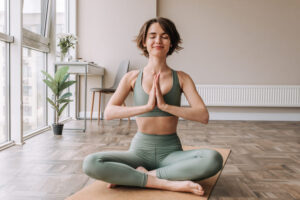Approximately one-third of adults in the United States reportedly experience somewhat fair or poor sleep quality that undermines their mental well-being and disrupts the execution of their routine tasks.
Are you one of the many individuals struggling with trouble sleeping? Do you feel lethargic despite taking 4-6 hours of nap, or do your thoughts race at night, hindering a peaceful slumber?
Don’t get worried, as we have listed here some of the best relaxing sleep exercises to help you fall asleep fast and enjoy a more tranquil sleep. So, let’s explore these workouts to improve your sleeping pattern!
7 Best Exercises for Restful Night Sleep


A routine workout is what rejuvenates your mind along with making you physically fit, leading to consistent and sound sleeping patterns. Here are a few simple yet effective exercises to help you achieve a healthy sleep duration of 6-8 hours.
Breathing Exercises for Deep Sleep
Deep breathing exercises can significantly contribute to establishing a healthy sleep pattern. These controlled breathing techniques aid in lowering blood pressure and alleviating symptoms of anxiety, ultimately promoting restful sleep. Commonly practiced breathing exercises for sleep include diaphragmatic breathing, alternate nostril breathing, belly breathing exercises, and the 4-7-8 breathing technique.
How to do?
Sit in a comfortable position and begin by taking deep inhalations, followed by slow exhalation. Hold your breath for a few seconds to ensure a prolonged intake of fresh air into the lungs. Repeat this process every night 10-15 times before going to sleep for optimal relaxation.
Aerobic Exercises or Cardio
Moderately intense cardio workouts or aerobic exercises have proven to be highly effective in addressing the symptoms of insomnia or anxiety. Activities such as jogging, swimming, and cycling, which fall under the category of cardio training, increase your heart rate and stimulate the release of dopamine. This hormone plays a pivotal role in boosting the sense of pleasure, enhancing focus, and improving sleep patterns.
How to do?
Initiate your cardio training with a moderate workout lasting 20-30 minutes, consistently engaging in this routine seven days a week.
Strength Training Exercises
Based on research findings, engaging in muscle training or resistance exercises, including activities like push-ups, squats, or weight-lifting, has been shown to significantly enhance sleep quality and alleviate signs of depression. It is essential to emphasize moderate training, as vigorous resistance exercises can be overly stimulating.
How to do?
Optimal results in resistance training are achieved during the evening. Initiate with a consistent 30-40 minute routine, gradually progressing to an hour daily. Consult with an expert trainer to tailor the type and duration of strength exercises to your individual needs.
Pilates to Improve Sleep Pattern
Recent research suggests that Pilates enhances sleep quality, though individuals over 40 may not experience significant impacts. Pilates effectively calms the mind, relieves stress, and stretches tense muscles, contributing to improved overall sleep patterns and a more restful and rejuvenating night.
How to do?
Initiate with a 20-minute Pilates exercise before bedtime, gradually extending if needed for better results. Adjusting the duration can enhance the effectiveness of this exercise in alleviating sleep deprivation and promoting a more relaxing night’s sleep.
Yoga


Incorporating yoga into your routine can significantly improve sleep quality. The gentle yet effective yoga practice, combining breath control, relaxation, and meditation, can effectively alleviate stress and calm your nervous system, hence creating an ideal environment for restful sleep. Every yoga pose is specific to each health concern, with poses like Child’s Pose, Forward Bend Pose, Supine Spinal Twist, and Locust Pose specifically performed to enhance sleep quality.
How to do?
Practice calming yoga poses regularly before bedtime. Focus on controlled breathing, gentle stretches, and mindfulness to relax your body and mind.
Tai Chi: Effective Exercise to Sleep Fast
Tai Chi, often referred to as moving meditation, involves a series of gentle body movements and controlled breathing. This activity promotes relaxation, combats depression, and enhances overall sleep quality. Incorporating Tai Chi into your routine, particularly in the evening, helps release tension accumulated throughout the day. Its meditative effects soothe the nervous system, signaling the body to prepare for a restful night’s sleep.
How to do?
Practice mild Tai Chai movements and harmonize them with deep breathing for optimal relaxation. Incorporating this practice into your evening routine or just before bedtime can give you the best results.
3 Effective Mental Exercises to do Before Sleep
Imagery Distraction or Visualization Techniques: Involve imagining a serene view to induce brain relaxation or assuming that you’re in a state of deep and comfortable sleep. While effective for some, others may struggle to control their thoughts. If this method does not suit you, consider exploring alternative practices mentioned below.
Progressive Muscle Relaxation Technique or PMR: Progressive Muscle Relaxation (PMR) involves a sequential contraction and relaxation technique, gradually releasing tension in muscles for enhanced relaxation and a peaceful night’s sleep. Begin tensing your toe muscles and gradually move upwards, applying a few seconds of tension to each muscle. Progressive Muscle Relaxation exercise targets approximately 16 muscle groups so can be best performed with proper training under an expert trainer.
Self-Hypnosis: Brain Exercise for Better Sleep: Hypnosis, characterized by deep relaxation and heightened focus, proves beneficial in addressing insomnia and sleep disorders. Follow these expert-guided steps for self-hypnosis to improve sleep quality:
- Select a specific phrase to be used in the self-hypnosis process before starting the procedure. You may choose whatever you want, like, relax, sleep, calm-down, I can handle it, etc.
- Choose a comfortable place, preferably before bedtime.
- Inhale and exhale slowly, focusing on your breath.
- Employ the Progressive Muscle Relaxation technique, ensuring relaxation throughout your body.
- Concentrate on relaxing your head, shoulders, neck, chest, back, legs, and feet.
- After sustained relaxation, repeat the suggestive sleep hypnosis phrase to yourself.
Conclusion
Integrating sleep exercises into your routine is a transformative approach, but patience is crucial as the body requires time to acclimate to a specific regimen. If one exercise proves ineffective, explore alternatives. Stick to your routine until you attain better sleep. Remember, consistency is the key to optimizing the benefits of exercise for sleep.
Frequently Asked Questions
Which type of exercise is best to get rid of insomnia?
Cardio workouts, also called aerobic exercises, are highly beneficial in alleviating the symptoms of insomnia. Among the most effective are running, cycling, and swimming.
What is a 4-7-8 sleep trick?
The 4-7-8 is a breathing exercise that involves gradual inhaling through the nose for 4 seconds, holding the breath for a count of 7 seconds, and then exhaling it for a count of 8.
Can we sleep after a workout?
After the workout, the best practice is to wait for around an hour before bedtime. This allows body temperature, heart rate, and adrenaline levels to return to normal, hence facilitating soothing sleep.
Why should we not sleep in the evening?
Sleeping in the evening is generally not advisable as it can cause lethargy and redundant stress. Some medical experts also claim that evening sleep may disturb the digestive process and hormonal balance.
What causes a lack of deep sleep?
Common reasons for sleep deprivation may include depression, anxiety, aging, and the use of certain medications.


